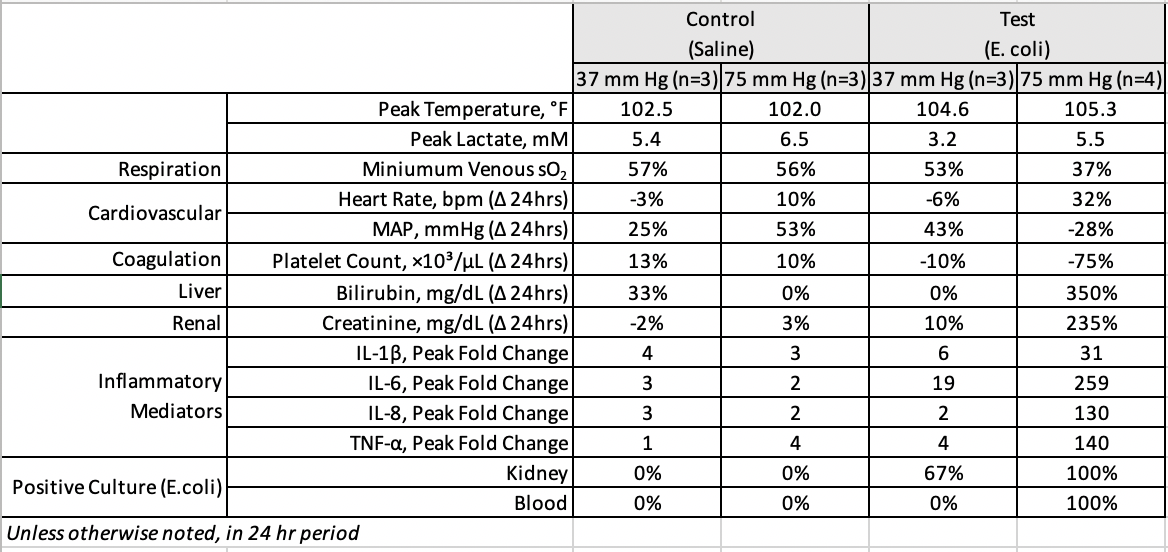Back
Poster, Podium & Video Sessions
Moderated Poster
MP44: Stone Disease: Surgical Therapy (including ESWL) III
MP44-07: Relationship between renal pelvis pressure and post-ureteroscopy infection in a live swine model
Sunday, May 15, 2022
1:00 PM – 2:15 PM
Location: Room 228
David Hinojosa-Gonzalez, Christina Kottooran, Boston, MA, Jennifer Saunders, Marle Franco, Marlborough, MA, Brian Eisner*, Boston, MA

Brian Howard Eisner, MD
Massachusetts General Hospital
Poster Presenter(s)
Introduction: Urosepsis is reported to occur after 5% of ureteroscopic stone procedures; rates of pyelonephritis are higher. In this study, a live swine model was used to evaluate the relationship between renal pelvis pressure and infection after ureteroscopy.
Methods: In anesthetized pigs (n=13; female; ~60 kg each), ureteroscopy was performed as follows: cystoscopy was performed to position a 0.014” pressure sensor guidewire (Comet™, Boston Scientific, Marlborough, MA) in the renal pelvis. A flexible ureteroscope was then introduced into the renal pelvis and the position of the ureteroscope and the pressure sensor wire were confirmed. Infusion of saline irrigation fluid alone or with a standardized concentration of uropathogenic e. coli strain CFT073 (1.5 x 107 CFU/ml) at target renal pelvic pressures (37 mm Hg and 75 mm Hg) was maintained for 60 minutes using a pressure bag and instantaneous feedback from the pressure-sensing guidewire. Venous blood sampling was performed during the procedure as well as at 1, 3,6, 12, and 24 hours after surgery. Vital signs were monitored, inflammatory biomarkers were assayed, and renal tissue and blood cultures were obtained.
Results: Thirteen (13) pig kidneys were used during the study and study groups were as follows: 37 mm Hg with saline irrigation (n=3), 75 mm Hg with saline irrigation (n=3), 37 mm Hg with saline irrigation with 1.5 x 107 CFU/ml e. coli added (n=3), and 75 mm Hg with saline irrigation with 1.5 x 107 CFU/ml e. coli added (n=4). Table 1 shows the results of the study: changes in inflammatory biomarkers were most pronounced in the 75 mm Hg saline irrigation + e. coli. All kidneys in both groups treated with saline + e. coli irrigation cultured positive for bacteria but interestingly, bacteremia was seen in 0/4 animals treated at 37 mm Hg with saline + e. coli irrigation and 4/4 animals treated at 75 mm Hg with saline + e. coli irrigation.
Conclusions: In this study of a swine model of ureteroscopy, irrigation with saline + e. coli produced an inflammatory response as well as positive kidney cultures (i.e. pyelonephritis). However, bacteremia was only seen in animals treated at 75 mmHg. These data suggest that there may be a renal pelvis pressure threshold above which it is more likely that animals with infected urine may develop post-ureteroscopy bacteremia.
Source of Funding: Boston Scientific Corporation

Methods: In anesthetized pigs (n=13; female; ~60 kg each), ureteroscopy was performed as follows: cystoscopy was performed to position a 0.014” pressure sensor guidewire (Comet™, Boston Scientific, Marlborough, MA) in the renal pelvis. A flexible ureteroscope was then introduced into the renal pelvis and the position of the ureteroscope and the pressure sensor wire were confirmed. Infusion of saline irrigation fluid alone or with a standardized concentration of uropathogenic e. coli strain CFT073 (1.5 x 107 CFU/ml) at target renal pelvic pressures (37 mm Hg and 75 mm Hg) was maintained for 60 minutes using a pressure bag and instantaneous feedback from the pressure-sensing guidewire. Venous blood sampling was performed during the procedure as well as at 1, 3,6, 12, and 24 hours after surgery. Vital signs were monitored, inflammatory biomarkers were assayed, and renal tissue and blood cultures were obtained.
Results: Thirteen (13) pig kidneys were used during the study and study groups were as follows: 37 mm Hg with saline irrigation (n=3), 75 mm Hg with saline irrigation (n=3), 37 mm Hg with saline irrigation with 1.5 x 107 CFU/ml e. coli added (n=3), and 75 mm Hg with saline irrigation with 1.5 x 107 CFU/ml e. coli added (n=4). Table 1 shows the results of the study: changes in inflammatory biomarkers were most pronounced in the 75 mm Hg saline irrigation + e. coli. All kidneys in both groups treated with saline + e. coli irrigation cultured positive for bacteria but interestingly, bacteremia was seen in 0/4 animals treated at 37 mm Hg with saline + e. coli irrigation and 4/4 animals treated at 75 mm Hg with saline + e. coli irrigation.
Conclusions: In this study of a swine model of ureteroscopy, irrigation with saline + e. coli produced an inflammatory response as well as positive kidney cultures (i.e. pyelonephritis). However, bacteremia was only seen in animals treated at 75 mmHg. These data suggest that there may be a renal pelvis pressure threshold above which it is more likely that animals with infected urine may develop post-ureteroscopy bacteremia.
Source of Funding: Boston Scientific Corporation


.jpg)
.jpg)